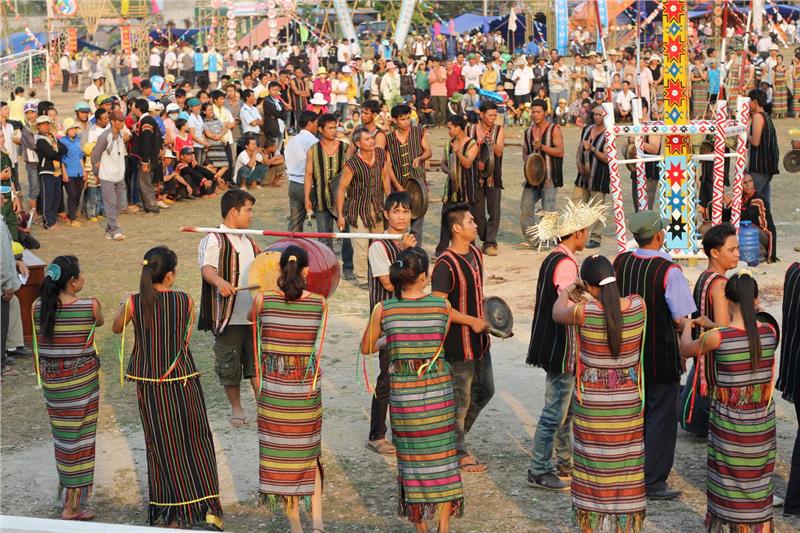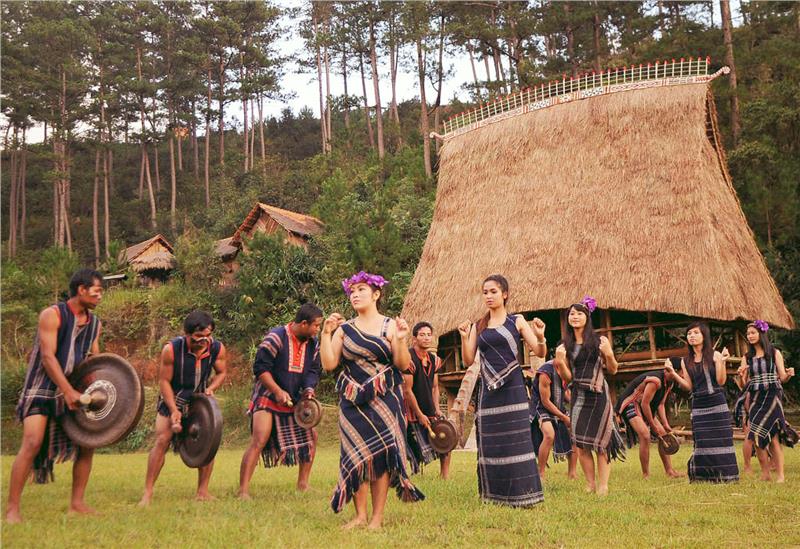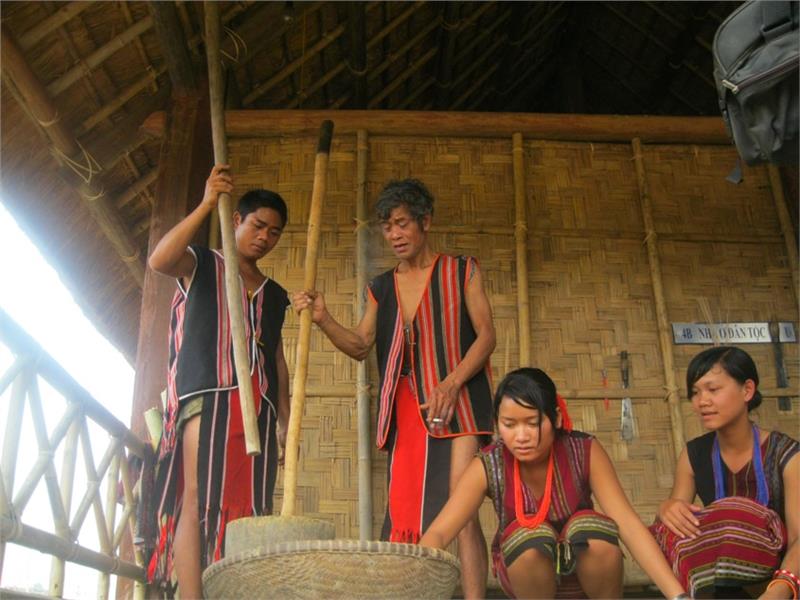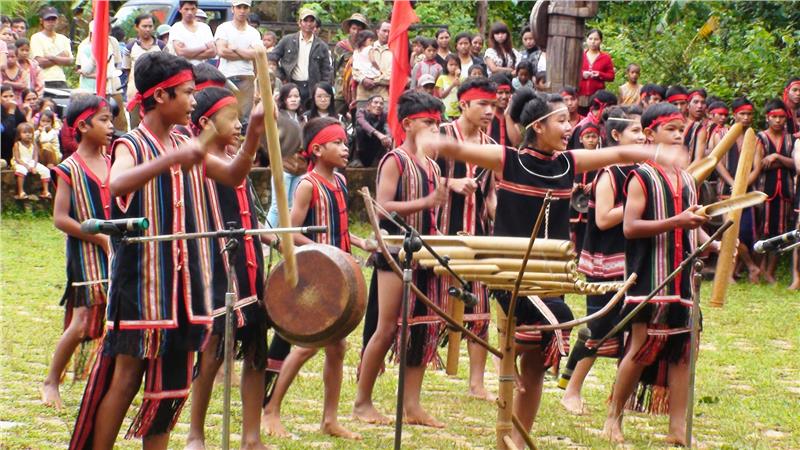Central Highlands, also known as Tay Nguyen, is a multi-cultural and multi-ethnic region in Vietnam. With the ancient architecture of spilt houses, the space of Gong culture and traditional festivals, the land has attracting a great number of tourists visiting each year to admire the beauty of the unique culture. However, local people here are still facing with some troubles to develop economics and society because of the unfavorable geography in Central Highland Vietnam.
Population: 5379, 6 people
Area: 54, 474 km2

The Central Highlands of Vietnam consists of five provinces, which are Kon Tum, Gia Lai, Dak Lak, Dak Nong and Lam Dong (arranged from the north to the south). The natural area of the Highlands is 54, 474 square kilometers accounting for 16.8% the total area of the whole country. The Central Highlands combined with the South Central Coast to form the South Central region of Vietnam. The land shares border with Quang Nam province in the north; Quang Ngai, Binh Dinh, Phu Yen, Khanh Hoa, Ninh Thuan, and Binh Thuan in the east; Binh Phuoc and the south of Dong Nai in the south; Attapeu province (Lao) and Ratanakiriva and Mondulkiri (Cambodia) in the west. In fact, the Central Highlands is not the only one plateau. It includes a series of adjacent plateaus, in details, Kon Tum (500m); Kon Plong, Kon Ha Nung and Play Ku (800m); M’Drak (500m); Buon Ma Thuot (500m); Mo Nong (800-1000m); Lam Vien (1500m) and Di Linh (900-1000m). The Central Highlands can be divided into three types of climate sub-regions, which are North Highlands (Kon Tum, Gia Lai), Central Highlands ( Dak Lak and Dak Nong), and South Highlands (Lam Dong).
In addition, the Central Highlands has many forests with biological diversity and large potential for tourism. The climate is divided into two seasons, rainy season from May to October and dry season from November to April. March and April are the hottest and driest time in a year. Due to the effects of altitude, the climate in plateaus in height of 400-500m is relatively cool and rainy, on the other hand, the weather in over 1000m plateaus is cool all year round as temperate regions.

A long time ago, the Central Highlands was an autonomous region of some ethnic groups. The land did not belong to any countries. Due to having extensive area but less people, the region was attacked by Champa Kingdom. In February, 1971, King Le Thanh Tong captured King Cham Pa in a war. After the victory, King Le Thanh Tong merged 3 parts of Cham Pa territory into Dai Viet (the old name of Vietnam) while the two remaining sections were divided into small kingdoms under Dai Viet domination. Later on, after Nguyen Hoang expanded lands to the south, Lord Nguyen tried to eliminate the power of Champa Kingdom in the Highlands and also sent some envoys to establish power in this area. Nonetheless, Lord Nguyen gave more concentration in plains; therefore, he only set very loose power here. However, the Central Highlands still remained under the protection of Lord Nguyen. Actually, the Central Highlands Vietnam history experienced many changes to form the current land. From 1976 to 1990, the Central Highlands included 3 provinces, which are Gia Lai, Kon Tum, and Lam Dong. Currently, there are 5 provinces in this region.
Central Highland Vietnam administration is divided into 61 district administrative units, including 5 provincial cities (Buon Ma Thuot, Pleiku, Dalat, Kon Tum, and Bao Loc); 4 district – level towns (An Khe, Ayun Pa, Buon Ho, Gia Nghia); 52 districts; and 722 commune-level administrative units (77 wards, 47 towns and 598 communes).
Politics in the Central Highlands Vietnam is sometimes not stable in comparison to other places of the country. In fact, the diversity of ethnic groups and religions in a small area sometimes causes conflicts among different religions and groups. However, thanks to the immediate intervention of Vietnam Government, these conflicts are solved quickly and do not become too complicated. Besides, in recent years, Vietnam Government has enacted strong policies in the Highlands to reach the sustainable development. According to the Government, the sustainable development aims to use natural resources appropriately, alleviate poverty, increase jobs and enhance the awareness of local people, which is considered as the best way to resolve conflicts. Especially, the Government has enacted specific policies for ethnic minority groups to focus on solving urgent politic problems in lands and religions and enhancing living standards for these groups.

According to General Statistics Office in 2012, the Central Highlands Vietnam population is 5379, 6 with the population density are 99 people per one kilometer. The population in ethnic groups is often unstable because of flows of free immigration. The region is really a multi-ethnic and multi-cultural area where 47 ethnic groups (Ba Na, Gia Rai, E De, Co Ho …) live in harmony with each other. Vietnamese people often call these groups as ethnic minority groups or “Thuong people” (people who live in the highlands or mountainous regions). Living standards and education of people here is not as high as other regions because of the difficulty in transportation, geography and economics. The Central Highland’s people are described as having vitality. They are also quite kind, honest and hospitable.

Ethnic minorities in the Central Highlands have a system of traditional villages such as Kon Ko Tu village, Kon Du village, Kon Soi village (Kon Tum); De K’tu (Gia Lai); Ako Dhung, Jun (Dak Lak); and K’ho, Mnong (Dak Nong, Lam Dong). The region also retains the traditional craftsmanship including brocade weaving, knitting, and statue carving. Besides, musical instruments, the Space of Gong culture, spilt houses and heroic epics are some other highlighted features of the Central Highlands Vietnam culture. The music here is unique and special with the sounds of some musical instruments like T’rung or Klong Put. Besides, in 2005, Gong culture of the Highlands was recognized as an intangible heritage of human by UNESCO. Travelling here, tourists can be clearly seen the strong acculturation happening through special architectures of stilt houses. In terms of religions, there are four main types including Catholic, Buddhist, Protestant, and Cao Dai.
In general, although the place has the largest number of ethnic minority groups in Vietnam; Vietnamese is still the main language because the majority of population is Kinh people. Similar to other region, local people here have their own dialects as well. Besides, other languages in Central Highlands Vietnam include languages of different ethnic groups.

With the features of basaltic soils (about 2 million hectares of fertile basalt, accounted for 60% of the whole country) at an altitude of 500 - 600m, the Central Highlands takes advantage of growing industrial crops, for example, coffee, cocoa, pepper, cashew, and rubber. Coffee is the most important industrial crop in the region with some famous brands like Trung Nguyen coffee and Buon Ma Thuot coffee. Besides, the Highlands is also the second largest rubber plantation. Thanks to a diverse system of waterfalls, the hydropower resources here are quite large and being used more and more efficiently. Some hydropower plants were constructed includes Da Nhim (160, 000 KW) on Da Nhim river, Dray H’inh (12, 000 KW) on Serepok river, and Yaly (700, 000 KW). In addtion, the Central Highlands is rich in bauxite reserves as well. According to a data of the former Soviet Union, the bauxite reserves in Central Highlands are approximately 8 billion tons. On November 1, 2007, the Vietnam Prime Minister signed a decision to research, exploit and process bauxite in a period of 2007 – 2015. Apart from these above strengths, the Central Highland Vietnam economy is not as developed as the other regions. The lack of highly skilled labor, the poor infrastructure, and the mountainous terrain is some problems which restrict the economic development of this land.

The Central Highlands society is quite different from other place. In fact, Thuong people have their own rule called the customary law. Besides, traditional family of ethnic minority groups like Ede or Mnong follows a system of matriarchal society. For them, the role of women in a family is highly appreciated. A woman in a family has rights to control everything in her family. These people also put the great attention to children. They condemn the abandon of children. In conclusion, the customary law of the Central Highlands people enhances the role of women and children.
Tourism

The diverse natural resources create the favorable conditions for the Central Highlands Vietnam tourism. This is a land of majestic waterfalls, mysterious mountains and forests. The highlighted features of the Highlands tourism is green tourism, which mainly concentrated on national parks (Yok Don, Chu Yang Sin – Dak Lak, Chu Mom Ray - Kon Tum, Kon Ka Kinh - Gia Lai, and Bidoup Nui Ba – Lam Dong); and Ngoc Linh Nature Reserve (Kon Tum). The sub-regions in the Central Highlands have a cool climate which is suitable for resort and tourism. Dalat is a typical example for this. Dalat is described as “a small Paris” with the dreamy beauty, cool weather and many stunning attractions. Besides, with the multi-ethnic and multi-cultural features, the region attracts tourists for its ancient historical value, unique cultural customs, ethnic musical instruments, folk festivals and so on. Especially, the space of gong culture which was recognized by UNESCO as masterpieces of the intangible culture is also a special thing for tourists.
Festivals

The Central Highland Vietnam festivals are born from a strong belief of local people in a God named Yang. The festivals often consist of cultural activities to help promote and enhance the strength of cooperation and attachment in the community. It also creates many chances for residents to perform traditionally musical instruments. Some typical festivals in the land are Buffalo Sacrifice Festival, Harvest Festival, Gong Festival and Elephant Race Festival …
Gong Festival
Gong Festival is held every year alternately in the Central Highland provinces. Dak Lak is an important place which is often chosen to organize the festival because of having the largest number of gongs in Vietnam. The Festival is not only the important event of the Central Highlands but also in Vietnam as well. During the festival, artisans of each province will perform the cultural space of their own province. Besides, the unique folk festivals of the Central Highlands will also be redrawn to attract the community participating in the protection of cultural values and introduce to tourists about Vietnam culture and tourism.
Harvest Festival
Every year, after harvesting (usually on November 5th), local people often celebrate a ceremony named Harvest Festival to express the gratitude to Gods and also enjoy the result after a long time of working hard. Although the ceremony in each ethnic group can be different in some aspects, it has the same meaning as mentioned above. Each family will hold their own festival. In the festival, members in the family have different roles. Wives often take the responsibility for cooking while husbands prepare for meat and wine. Sons will cut firewood while daughters pound rice. After finishing the preparation and ritual, the family will invite their neighbors to enjoy the festival together.
